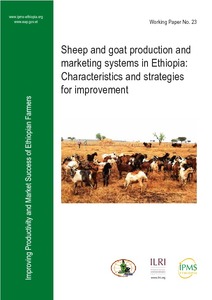Resource information
Ethiopia is home for a large and diverse livestock resources and favourable production environments. The vast majority of the rural population’s livelihood is partly based on livestock production. However, livestock production and productivity and producers’ benefits from livestock production are far below expectations. Understanding the livestock production and marketing characteristics and producers’ needs and perceptions, identifying constraints and opportunities, and designing workable production strategies are required in order to improve livestock productivity and market success of producers.
Based on a series of IPMS studies, this paper synthesises and analyses the characteristics, constraints and opportunities of sheep and goat production and marketing in Ethiopia.
The paper also puts forward strategic interventions for improving sheep and goat
productivity and producers market success.
Livestock production systems in Ethiopia have evolved largely as a result of the influence of the natural production environments and socio-economic circumstances of farmers/ pastoralists, rather than market forces. Livestock production is of subsistence nature. Like all other livestock species, sheep and goat in Ethiopia are kept under traditional extensive systems with no or minimal inputs and improved technologies, which results in characteristically low productivity. They are virtually kept as scavengers, particularly in the mixed crop–livestock systems. Sheep and goat are largely produced in mixed crop–livestock, specialized pastoral and agropastoral systems. Market-oriented or commercial production is almost non-existent. Small flock sizes predominate in the highland mixed crop–livestock systems because of land and capital limitations. Relatively larger flocks are maintained in the lowland (agro) pastoral systems. The major feed resources for sheep and goats include grazing on communal natural pasture, crop stubble, fallow grazing, road side grazing, crop residues, browses, and non-conventional feeds (household food leftovers, weeds, crop tillers and fillers). Production of improved forages, improvement of low quality feed sources such as crop residues and supplementary feeding (except fattening) is almost non-existent.


